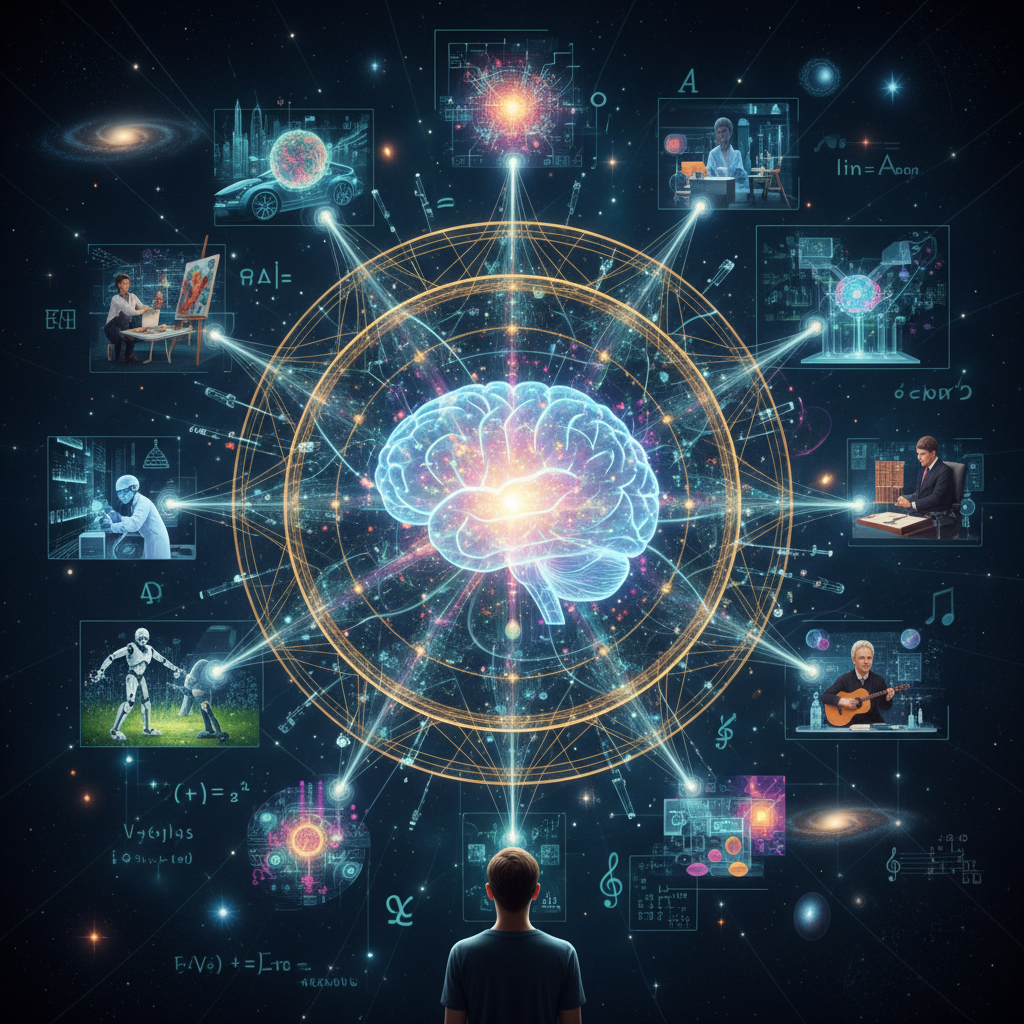Artificial General Intelligence (AGI) is a term that has been tossed around like a hot potato in tech circles, yet its true meaning often eludes even the most seasoned AI enthusiasts. Unlike its cousin, Artificial Intelligence (AI), which is designed to perform specific tasks, AGI aims to mimic the full range of human intelligence. But what does artificial general intelligence actually mean in practical terms? Let's dive into this fascinating topic and unravel the mysteries surrounding AGI.
Key Takeaways:
- Understanding AGI: AGI refers to AI systems that possess human-like cognitive abilities, capable of performing any intellectual task that a human can.
- Current State: While AI has made significant strides in specific areas, achieving true AGI remains a distant goal.
- Implications and Risks: The development of AGI could revolutionize industries but also poses significant ethical and existential risks.
1. The Genesis of Artificial General Intelligence
The concept of AGI is not a new kid on the block. It has its roots in the early days of AI research, where the dream was to create machines that could think and learn like humans. The idea was to develop AI systems that could perform tasks with the same sense of understanding and adaptability as a human being. This vision has driven countless computer scientists and AI researchers to explore the depths of machine intelligence.
AGI is often depicted in science fiction as machines with human-like intelligence, capable of solving complex problems and interacting with the world in a human-like manner. However, the reality is that we are still far from achieving this level of sophistication. Current AI systems, often referred to as narrow AI or weak AI, are designed to excel in specific tasks but lack the general cognitive abilities that characterize human intelligence.
2. Human Intelligence vs. Machine Intelligence
Human intelligence is a complex tapestry woven from various cognitive abilities, including sensory perception, language understanding, and problem-solving skills. The human brain is a marvel of nature, capable of learning from experience, adapting to new situations, and performing a wide range of intellectual tasks. In contrast, AI systems are typically designed to tackle specific problems, using algorithms and training data to generate human-like responses.
Machine learning, a subset of AI, has made significant strides in recent years, particularly with the advent of deep learning models and neural networks. These technologies have enabled AI systems to perform tasks such as image recognition, language translation, and even playing complex games like Go at a level that surpasses human capabilities. However, these systems still lack the general intelligence required to understand and interact with the world in the same way humans do.
3. The Quest for Human-Like Intelligence
The pursuit of AGI is akin to chasing a mirage in the desert. While the goal is clear, the path to achieving it is fraught with challenges and uncertainties. AI researchers are constantly exploring new approaches to bridge the gap between narrow AI and AGI, seeking to develop systems that can perform tasks with human-level performance.
One promising avenue of research is the development of generative AI models, which are designed to generate human language and other forms of creative output. These models, such as large language models, have shown remarkable capabilities in generating coherent and contextually relevant text. However, they still fall short of true AGI, as they lack the ability to understand and reason about the world in the same way humans do.
4. Cognitive Abilities and AGI
Cognitive abilities are the building blocks of human intelligence, encompassing skills such as memory, attention, and problem-solving. For AGI to become a reality, AI systems must be able to replicate these abilities in a way that allows them to perform a wide range of cognitive tasks. This requires a deep understanding of how the human brain processes information and adapts to new situations.
AI researchers are exploring various approaches to mimic human cognitive capabilities, including the use of neural networks and deep learning models. These technologies have shown promise in tasks such as image recognition and natural language processing, but they still lack the flexibility and adaptability of human intelligence. The challenge lies in developing AI systems that can learn from experience and apply their knowledge to new and unfamiliar situations.
5. The Role of AI Tools in Developing AGI
AI tools play a crucial role in the development of AGI, providing the building blocks for creating more advanced and capable systems. These tools include machine learning algorithms, neural networks, and large language models, which are used to train AI systems to perform specific tasks. However, the development of AGI requires more than just advanced tools; it requires a fundamental shift in how we approach AI research.
One of the key challenges in developing AGI is the need for AI systems to possess a deep understanding of the world and the ability to reason about complex problems. This requires a combination of advanced algorithms, vast amounts of training data, and a deep understanding of human cognitive abilities. AI researchers are exploring new approaches to achieve this, including the use of generative AI models and other emerging technologies.
6. The Impact of AGI on Human Capabilities
The development of AGI has the potential to augment human intelligence and revolutionize industries across the globe. By creating AI systems that can perform tasks with human-level performance, we can unlock new possibilities in fields such as medical research, drug discovery, and autonomous systems. However, the impact of AGI on human capabilities is not without its challenges and risks.
One of the key concerns is the potential for AGI to surpass human capabilities in certain areas, leading to significant ethical and existential risks. As AI systems become more capable, there is a risk that they could be used to automate economically valuable work, leading to job displacement and other societal challenges. It is crucial for AI researchers and policymakers to carefully consider the implications of AGI and develop strategies to mitigate these risks.
7. The Challenges of Developing AGI
Developing AGI is no walk in the park. It requires a deep understanding of human intelligence and the ability to replicate it in a machine. This is a complex and multifaceted challenge that involves a wide range of disciplines, including computer science, neuroscience, and cognitive psychology.
One of the key challenges in developing AGI is the need for AI systems to possess a deep understanding of the world and the ability to reason about complex problems. This requires a combination of advanced algorithms, vast amounts of training data, and a deep understanding of human cognitive abilities. AI researchers are exploring new approaches to achieve this, including the use of generative AI models and other emerging technologies.
8. The Role of AI Researchers in Advancing AGI
AI researchers are the unsung heroes in the quest for AGI, working tirelessly to push the boundaries of what is possible with machine intelligence. Their work involves developing new algorithms, exploring novel approaches to AI research, and collaborating with experts from other fields to gain a deeper understanding of human intelligence.
One of the key areas of focus for AI researchers is the development of AI systems that can perform tasks with human-level performance. This requires a deep understanding of human cognitive abilities and the ability to replicate them in a machine. AI researchers are exploring various approaches to achieve this, including the use of neural networks, deep learning models, and other advanced technologies.
9. The Role of Machine Learning in AGI
Machine learning is the backbone of modern AI systems, providing the tools and techniques needed to train AI systems to perform specific tasks. However, the development of AGI requires more than just advanced machine learning algorithms; it requires a fundamental shift in how we approach AI research.
One of the key challenges in developing AGI is the need for AI systems to possess a deep understanding of the world and the ability to reason about complex problems. This requires a combination of advanced algorithms, vast amounts of training data, and a deep understanding of human cognitive abilities. AI researchers are exploring new approaches to achieve this, including the use of generative AI models and other emerging technologies.
10. The Role of Neural Networks in AGI
Neural networks are a key component of modern AI systems, providing the building blocks for creating more advanced and capable systems. These networks are designed to mimic the way the human brain processes information, allowing AI systems to learn from experience and adapt to new situations.
One of the key challenges in developing AGI is the need for AI systems to possess a deep understanding of the world and the ability to reason about complex problems. This requires a combination of advanced algorithms, vast amounts of training data, and a deep understanding of human cognitive abilities. AI researchers are exploring new approaches to achieve this, including the use of generative AI models and other emerging technologies.
11. The Role of Generative AI in AGI
Generative AI is a promising avenue of research in the quest for AGI, providing the tools and techniques needed to create AI systems that can generate human-like language and other forms of creative output. These models, such as large language models, have shown remarkable capabilities in generating coherent and contextually relevant text.
One of the key challenges in developing AGI is the need for AI systems to possess a deep understanding of the world and the ability to reason about complex problems. This requires a combination of advanced algorithms, vast amounts of training data, and a deep understanding of human cognitive abilities. AI researchers are exploring new approaches to achieve this, including the use of generative AI models and other emerging technologies.
12. The Role of Large Language Models in AGI
Large language models are a key component of modern AI systems, providing the tools and techniques needed to create AI systems that can generate human-like language and other forms of creative output. These models have shown remarkable capabilities in generating coherent and contextually relevant text.
One of the key challenges in developing AGI is the need for AI systems to possess a deep understanding of the world and the ability to reason about complex problems. This requires a combination of advanced algorithms, vast amounts of training data, and a deep understanding of human cognitive abilities. AI researchers are exploring new approaches to achieve this, including the use of generative AI models and other emerging technologies.
13. The Role of Training Data in AGI
Training data is the lifeblood of modern AI systems, providing the information needed to train AI systems to perform specific tasks. However, the development of AGI requires more than just vast amounts of training data; it requires a deep understanding of human cognitive abilities and the ability to replicate them in a machine.
One of the key challenges in developing AGI is the need for AI systems to possess a deep understanding of the world and the ability to reason about complex problems. This requires a combination of advanced algorithms, vast amounts of training data, and a deep understanding of human cognitive abilities. AI researchers are exploring new approaches to achieve this, including the use of generative AI models and other emerging technologies.
14. The Role of Cognitive Tasks in AGI
Cognitive tasks are the building blocks of human intelligence, encompassing skills such as memory, attention, and problem-solving. For AGI to become a reality, AI systems must be able to replicate these abilities in a way that allows them to perform a wide range of cognitive tasks.
One of the key challenges in developing AGI is the need for AI systems to possess a deep understanding of the world and the ability to reason about complex problems. This requires a combination of advanced algorithms, vast amounts of training data, and a deep understanding of human cognitive abilities. AI researchers are exploring new approaches to achieve this, including the use of generative AI models and other emerging technologies.
15. The Role of Cognitive Capabilities in AGI
Cognitive capabilities are the building blocks of human intelligence, encompassing skills such as memory, attention, and problem-solving. For AGI to become a reality, AI systems must be able to replicate these abilities in a way that allows them to perform a wide range of cognitive tasks.
One of the key challenges in developing AGI is the need for AI systems to possess a deep understanding of the world and the ability to reason about complex problems. This requires a combination of advanced algorithms, vast amounts of training data, and a deep understanding of human cognitive abilities. AI researchers are exploring new approaches to achieve this, including the use of generative AI models and other emerging technologies.
16. The Role of Human Language in AGI
Human language is a key component of human intelligence, providing the tools and techniques needed to communicate and interact with the world. For AGI to become a reality, AI systems must be able to understand and generate human language in a way that allows them to perform a wide range of cognitive tasks.
One of the key challenges in developing AGI is the need for AI systems to possess a deep understanding of the world and the ability to reason about complex problems. This requires a combination of advanced algorithms, vast amounts of training data, and a deep understanding of human cognitive abilities. AI researchers are exploring new approaches to achieve this, including the use of generative AI models and other emerging technologies.
17. The Role of Human-Level Performance in AGI
Human-level performance is the holy grail of AGI, providing the benchmark for creating AI systems that can perform tasks with the same level of understanding and adaptability as a human being. This requires a deep understanding of human cognitive abilities and the ability to replicate them in a machine.
One of the key challenges in developing AGI is the need for AI systems to possess a deep understanding of the world and the ability to reason about complex problems. This requires a combination of advanced algorithms, vast amounts of training data, and a deep understanding of human cognitive abilities. AI researchers are exploring new approaches to achieve this, including the use of generative AI models and other emerging technologies.
18. The Role of Human-Like Cognitive Abilities in AGI
Human-like cognitive abilities are the building blocks of human intelligence, encompassing skills such as memory, attention, and problem-solving. For AGI to become a reality, AI systems must be able to replicate these abilities in a way that allows them to perform a wide range of cognitive tasks.
One of the key challenges in developing AGI is the need for AI systems to possess a deep understanding of the world and the ability to reason about complex problems. This requires a combination of advanced algorithms, vast amounts of training data, and a deep understanding of human cognitive abilities. AI researchers are exploring new approaches to achieve this, including the use of generative AI models and other emerging technologies.
19. The Role of Human-Like Intelligence in AGI
Human-like intelligence is the holy grail of AGI, providing the benchmark for creating AI systems that can perform tasks with the same level of understanding and adaptability as a human being. This requires a deep understanding of human cognitive abilities and the ability to replicate them in a machine.
One of the key challenges in developing AGI is the need for AI systems to possess a deep understanding of the world and the ability to reason about complex problems. This requires a combination of advanced algorithms, vast amounts of training data, and a deep understanding of human cognitive abilities. AI researchers are exploring new approaches to achieve this, including the use of generative AI models and other emerging technologies.
20. The Role of Human-Like Performance in AGI
Human-like performance is the holy grail of AGI, providing the benchmark for creating AI systems that can perform tasks with the same level of understanding and adaptability as a human being. This requires a deep understanding of human cognitive abilities and the ability to replicate them in a machine.
One of the key challenges in developing AGI is the need for AI systems to possess a deep understanding of the world and the ability to reason about complex problems. This requires a combination of advanced algorithms, vast amounts of training data, and a deep understanding of human cognitive abilities. AI researchers are exploring new approaches to achieve this, including the use of generative AI models and other emerging technologies.
21. The Role of Human-Like Capabilities in AGI
Human-like capabilities are the building blocks of human intelligence, encompassing skills such as memory, attention, and problem-solving. For AGI to become a reality, AI systems must be able to replicate these abilities in a way that allows them to perform a wide range of cognitive tasks.
One of the key challenges in developing AGI is the need for AI systems to possess a deep understanding of the world and the ability to reason about complex problems. This requires a combination of advanced algorithms, vast amounts of training data, and a deep understanding of human cognitive abilities. AI researchers are exploring new approaches to achieve this, including the use of generative AI models and other emerging technologies.

Summary
Artificial General Intelligence represents the pinnacle of AI research, aiming to create systems that can perform any intellectual task a human can. While current AI systems excel in specific areas, achieving true AGI remains a distant goal. The development of AGI could revolutionize industries but also poses significant ethical and existential risks. As we continue to explore the possibilities of AGI, it is crucial to consider the implications and develop strategies to mitigate potential risks.
Your Friend,
Wade

Q1: What is the difference between AI and AGI?
AI refers to systems designed to perform specific tasks, while AGI aims to mimic the full range of human intelligence, capable of performing any intellectual task a human can.
Q2: What are the potential risks of developing AGI?
The development of AGI poses significant ethical and existential risks, including job displacement, ethical concerns, and the potential for AI systems to surpass human capabilities.
Q3: How close are we to achieving AGI?
While AI has made significant strides in specific areas, achieving true AGI remains a distant goal. Researchers are exploring new approaches and technologies to bridge the gap between narrow AI and AGI.









